Insect repellents are applied on your skin and clothes to keep away (repel) insects. They can help protect you from biting insects like mosquitoes and sandflies. This is especially important for travellers visiting countries where mosquitoes spread diseases such as malaria, dengue fever, Zika and yellow fever.
Insect repellents
How to use insect repellents safely
Key points about insect repellents
- Insect repellents are applied on your skin and clothes to keep away (repel) insects.
- They can help protect you from biting insects like mosquitoes and sandflies.
- Find out how to use them safely and possible side effects.

Mosquitoes are attracted to skin odours and the carbon dioxide we exhale. They also use heat, movement and visual cues to find a possible host. Repellents create a barrier that affects an insect's senses, such as smell and taste, to prevent it from finding a human host.
There are a variety of insect repellents available in New Zealand. They are available in different forms, such as a spray, stick, roll-on, cream or gel, which are applied to your skin. Check the active ingredient in the insect repellent you are buying, as not all have been proven to work. Insect repellents containing the following active ingredients provide reasonably long-lasting protection:
- diethyltoluamide (DEET)
- picaridin (also known as icaridin)
- IR3535
- oil of lemon eucalyptus (also known as OLE or PMD).
Also check the strength of the ingredient it contains. This is usually described as a percentage (%). Repellents containing 20–50% DEET are recommended (use a maximum of 30% DEET for children). High concentrations of DEET protect for longer, but there is no additional benefit to using products with more than 50% DEET. Other products containing 20–25% picaridin and those containing about 30% oil of lemon eucalyptus can also be used.
Sweat, water contact and rubbing from clothing can affect how long a repellent may be effective. Water resistant repellents are available.
There are some insect repellents made from a blend of herbs and essential oils such as citronella, lavender, lemongrass, rosemary, tea tree, eucalyptus and peppermint. These generally have a weaker or shorter-lived repellent effect. They may be more suitable where there is no risk of exposure to mosquito-borne diseases. Read more about essential oils and how to use them safely.
Where possible, avoid exposing your baby or child to mosquitoes. Consider staying indoors, using pram netting or dressing them in loose long-sleeved clothing, socks and shoes. Before using an insect repellent on your baby or child, check that it is suitable for their age. The following is a guide:
- DEET: Not recommended for babies younger than 2 months.
- Picaridin: Not recommended for children younger than 2 years.
- IR3535: Not recommended for babies younger than 6 months.
- Oil of lemon eucalyptus: Not recommended for children younger than 3 years.
It's important to apply insect repellents correctly. See using insect repellents correctly below.
Insect repellents containing DEET, picaridin, oil of lemon eucalyptus (OLE), or IR3535 can be used by pregnant or breastfeeding women when used according to the product label.5
 If you need to use repellent and sunscreen together, it is best to apply the sunscreen first, let it dry and then apply insect repellent over the sunscreen. Sunscreen does not affect repellent effectiveness, but the repellent may decrease sunscreen effectiveness. You may need to reapply sunscreen more frequently and in larger amounts.
If you need to use repellent and sunscreen together, it is best to apply the sunscreen first, let it dry and then apply insect repellent over the sunscreen. Sunscreen does not affect repellent effectiveness, but the repellent may decrease sunscreen effectiveness. You may need to reapply sunscreen more frequently and in larger amounts.
Using certain types of sunscreen and repellent together can increase the amount of repellent absorbed through the skin. Combined sunscreen and repellent products are available but not generally recommended. This is because repellent action usually lasts for several hours, whereas sunscreen may need to be reapplied more frequently.
Use insect repellents correctly to get the most benefit and reduce your risk of harm.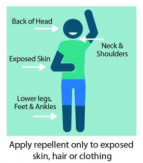 Where to apply
Where to apply
- Apply repellent only to exposed skin or clothing. Do not apply repellent underneath clothing. This can increase the amount of repellent that is absorbed into your skin.
- Do not apply repellent to wounds, open cuts, irritated or sunburned skin, eyes or mouth.
How much to use
- Follow the instructions on the label and do not exceed the recommended application frequency. Avoid applying too much repellent and too often. Apply just enough of a repellent to cover exposed skin. Using excessive amounts does not make it more effective. If biting insects do not respond to a thin film of repellent, apply a bit more.
- If you are outdoors for long periods or doing activities that cause profuse sweating, you may need to reapply repellent. Follow label directions to find out how long to wait before reapplying. Repellents do wash off in water, so if you are doing water activities, use a water resistant repellent or re-apply as mentioned in the directions for use.
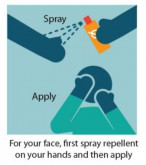 Using a spray
Using a spray
- If using a spray, do not spray repellent on your face, in your ears or near your eyes or mouth. To apply a spray repellent to your face, first apply it to your hands and then rub it onto your face.
Babies and children
- Before using an insect repellent on your baby or child, check that it is suitable for their age (see above).
- Children under 10 years should not apply their own repellent. Instead, adults should apply it to their own hands first and then gently spread on your child’s exposed skin.
- To avoid potential ingestion during eating, do not apply repellent to the hands, fingers or palms of young children.
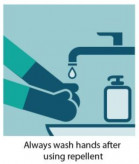 Wash after use
Wash after use
- Wash your hands after application to avoid accidentally putting repellent in your eyes.
- After returning indoors, wash repellent-treated skin with soap and water, or bathe. Likewise, after returning indoors, wash children’s treated skin and clothing with soap and water or give the child a bath.
You can apply DEET or other regular insect repellent directly onto clothing, but this then has to be reapplied at regular intervals the same as when you use it on skin.
Permethrin can be applied to clothing, hats, shoes, bed nets, jackets and camping gear for added protection. Examples of available products to do this with include Sawyer Permethrin Clothing Insect Repellent® and Repel Permethrin Treatment Kit For Fabric®. Clothing and other items must be treated 24–48 hours in advance of travel to allow them to dry.
Alternatively, clothing can be bought pretreated with permethrin. Permethrin-treated materials retain their ability to repel or kill insects after repeated washes. Check the label for the number of washes that the repellent lasts for.
When used as directed, side effects due to insect repellents are rare. They can cause skin irritation, eye irritation and headache. If you get a rash or itching from an insect repellent, wash off the product using mild soap and water and discontinue its use.
Read more about medicines and side effects and reporting a reaction you think might be a side effect.
The following links have more information on insect repellents. Be aware that websites from other countries may have information that differs from New Zealand recommendations.
Insect repellents – guidelines for safe use(external link) The Royal Children's Hospital, Melbourne, Australia
Insect repellents help prevent malaria and other diseases spread by mosquitoes(external link) CDC, US
Mosquito repellents(external link) University of Florida, US
Resources
5 questions to ask about your medications(external link)(external link)(external link) Health Quality and Safety Commission, NZ, 2019 English(external link), te reo Māori(external link)
References
- Insect repellents(external link) National Pesticide Information Centre
- Efficacy of insect repellents currently available in NZ(external link) ESR, NZ
- Mosquitoes, ticks and other arthropods(external link) Yellow Book, CDC, US
- Zika virus(external link) Health New Zealand | Te Whatu Ora
Brochures
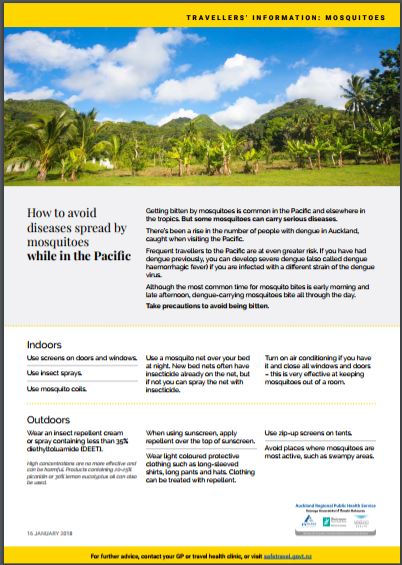
National Public Health Service – Northern Region, 2018
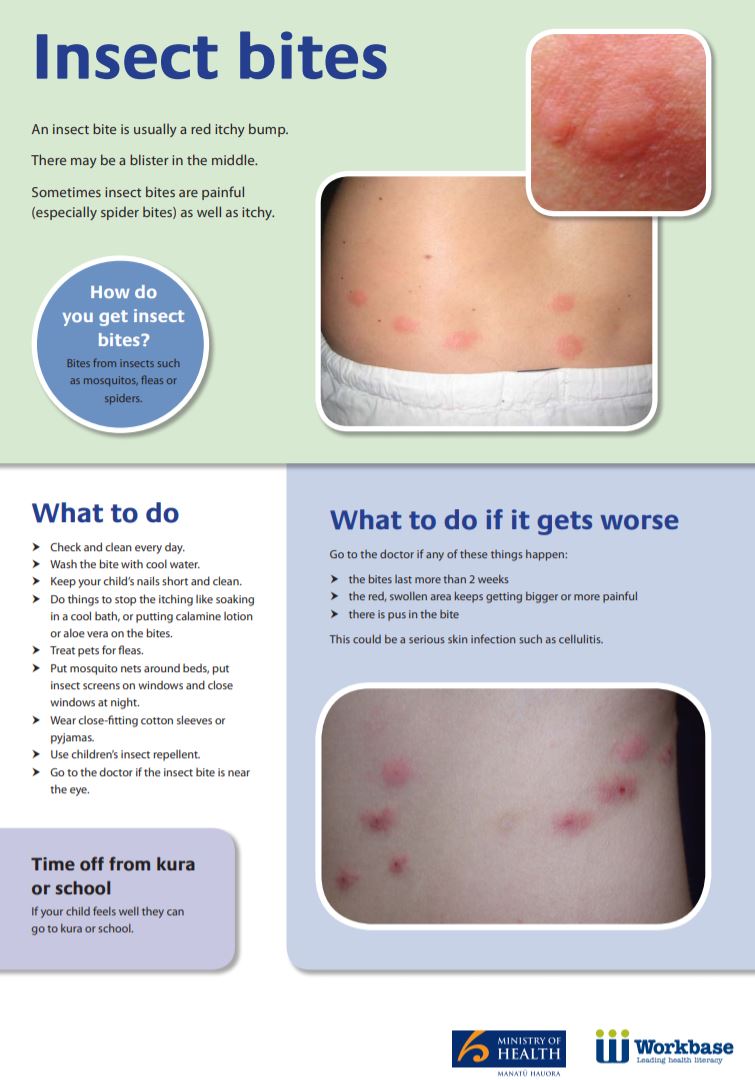
Workbase Education Trust and Ministry of Health, NZ, 2013
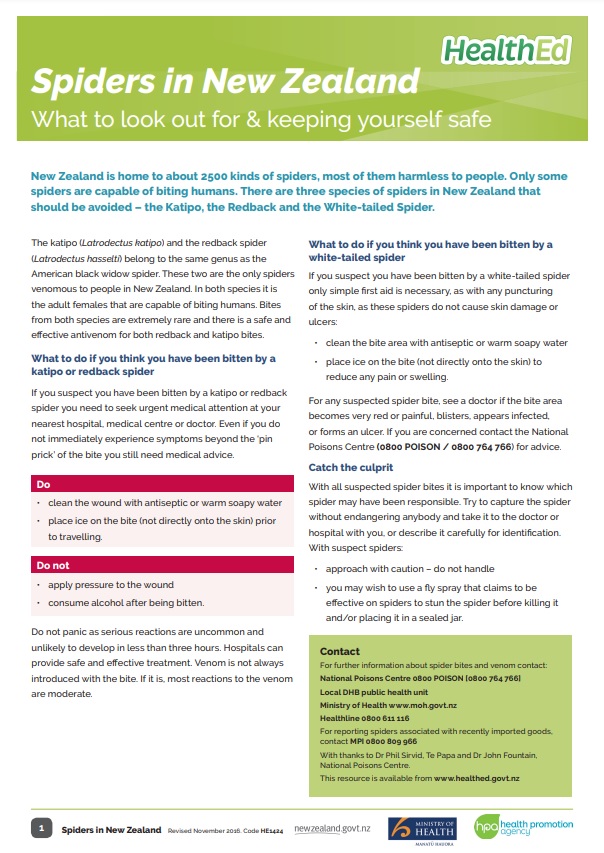
HealthEd, NZ, 2019
Credits: Sandra Ponen, Pharmacist, Healthify He Puna Waiora. Healthify is brought to you by Health Navigator Charitable Trust.
Reviewed by: Dr Li-Wern Yim, Travel Doctor
Last reviewed:
Page last updated:





